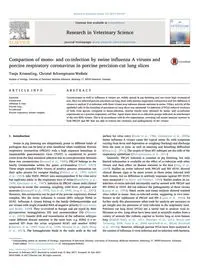
2017 Comparison of mono- and co-infection by swine influenza A viruses and porcine respiratory coronavirus in porcine pr PDF
Preview 2017 Comparison of mono- and co-infection by swine influenza A viruses and porcine respiratory coronavirus in porcine pr
Contents lists available at ScienceDirect Research in Veterinary Science journal homepage: www.elsevier.com/locate/rvsc Comparison of mono- and co-infection by swine influenza A viruses and porcine respiratory coronavirus in porcine precision-cut lung slices Tanja Krimmling, Christel Schwegmann-Weßels⁎ Institute of Virology, University of Veterinary Medicine Hannover, Bünteweg 17, 30559 Hannover, Germany A R T I C L E I N F O Keywords: Coronavirus Influenza A virus Porcine lung Co-infection Porcine respiratory disease complex A B S T R A C T Coronaviruses as well as influenza A viruses are widely spread in pig fattening and can cause high economical loss. Here we infected porcine precision-cut lung slices with porcine respiratory coronavirus and two Influenza A viruses to analyze if co-infection with these viruses may enhance disease outcome in swine. Ciliary activity of the epithelial cells in the bronchus of precision-cut lung slices was measured. Co-infection of PCLS reduced virulence of both virus species compared to mono-infection. Similar results were obtained by mono- and co-infection experiments on a porcine respiratory cell line. Again lower titers in co-infection groups indicated an interference of the two RNA viruses. This is in accordance with in vivo experiments, revealing cell innate immune answers to both PRCoV and SIV that are able to restrict the virulence and pathogenicity of the viruses. 1. Introduction Swine in pig fattening are ubiquitously prone to different kinds of pathogens that can be fatal or even beneficial when combined. Porcine respiratory coronavirus (PRCoV) with a high sequence homology to transmissible gastroenteritis virus (TGEV) is considered to protect swine from the fatal intestinal infection due to cross-protection between these two coronaviruses (Bernard et al., 1989). PRCoV belongs to the family Coronaviridae within the genus α-Coronavirus (Thiel, 2007). These single stranded RNA viruses of positive genome orientation use their spike protein for receptor binding (Delmas et al., 1992; Siddell et al., 1983). Like TGEV, PRCoV uses aminopeptidase N for virus entry but replicates solely in the respiratory tract of swine (Rasschaert et al., 1990; Rasschaert et al., 1987). Infection by PRCoV causes mild clinical symptoms in swine like sneezing, coughing, mild fever, polypnea and anorexia (Bourgueil et al., 1992; Cox et al., 1990; Jung et al., 2007). However, this coronavirus can be part of the porcine respiratory disease complex, like the swine influenza A viruses (SIV) subtype H3N2 or H1N1. Influenza A viruses belong to the family Orthomyxoviridae and are viruses with single stranded RNA of negative polarity (Kuntz-Simon and Madec, 2009). They co-evolved in Europe and are typed by their glycoproteins hemagglutinin (H) and neuraminidase (N) (Marozin et al., 2002). Genetic drift and reassortment of the influenza subtypes cause different disease outcome in the same host, e.g. H3N2 is a re- assorted SIV from the avian originated H1N1 and another H3N2 (Castrucci et al., 1993; Guan et al., 1996; Marozin et al., 2002; Meng et al., 2013). The hemagglutinin binds to the sialic acids at the cell surface for virus entry (Doms et al., 1986; Gambaryan et al., 2005). Swine influenza A viruses cause the typical swine flu with symptoms varying from fever and depression or coughing (barking) and discharge from the nose or eyes, as well as sneezing and breathing difficulties (Meng et al., 2013). The targets of these SIV subtypes are the cells of the respiratory epithelium (Punyadarsaniya et al., 2011). Generally, PRCoV infection is common in pig fattening, but only limited information is available on the effect of co-infection with other viruses and their effect on disease outcome in the host (Jung et al., 2009). Studies on swine infected with PRCoV and SIV H1N1 showed clinical disease signs to be more severe in those swine infected with both viruses, but no difference in antibody responses against SIV H1N1 were measured (Van Reeth and Pensaert, 1994). Earlier studies on co- infection of swine infected intranasally and by aerosol with PRCoV and SIV H3N2 or H1N1 did not enhance the pathogenicity of these viruses (Lanza et al., 1992). Nasal swabs and tissue analysis showed isolated virus rather in mono- than co-infected swine, suggesting in vivo inter- ference in the replication of PRCoV and SIV (Lanza et al., 1992). To further study this phenomenon other tools for analysis are necessary to get insight into the processes of viral infection in the respiratory tract. Precision cut lung slices (PCLS) are a useful tool to analyze viral in- filtration ex vivo. Lung slices have been used in scientific studies from a variety of animals like rodents, caprine or bovine lung or even human lung (Abdull Razis et al., 2011; Banerjee et al., 2012; Braun and Tschernig, 2006; Goris et al., 2009; Kirchhoff et al., 2014a; Kirchhoff et al., 2014b). However, although porcine PCLS have been analyzed in the context of influenza A virus infection and co-infection with bacteria, http://dx.doi.org/10.1016/j.rvsc.2017.07.016 Received 12 February 2017; Received in revised form 31 May 2017; Accepted 16 July 2017 ⁎ Corresponding author at: Institute of Virology, Department of Infectious Diseases, University of Veterinary Medicine Hannover, Bünteweg 17, 30559 Hannover, Germany. E-mail address:
